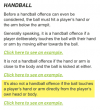With regards to deflecting from one body part to the hand/arm no longer taken into consideration...
I find it strange that the law allows proximity to be a factor when an opponent plays the ball, yet proximity is not considered when the ball deflects off a player themselves. If a player cannot move their arm in time due to proximity of an opponent's strike, how can they be expected to move their arm when their own deflection is much much closer?
I think you are overthinking this and finding a distinction that doesn't exist.
There are two kinds of handling (other than the attacking scorer):
Deliberate handling: This is solely about whether ITOOTR the handling was deliberate. In evaluating that, we get to use the criteria that we see fit, the most common of which is whether the ball was moving towards the ball. When an arm is left in a position where it gets hit by the ball, that can be deliberate
if the player had the opportunity to get the arm out of the way and didn't. Whether he had the opportunity to get out of the way could be impacted by a deflection off an opponent or himself--and the play is probably going to be evaluated by the "biggering" criteria.
Biggering: When a player makes himself unnaturally bigger, he accepts the consequence of that action. It doesn't matter whether the ball comes from close or deflects--the action of making himself unnaturally bigger means he has taken the risk of whatever happens. (As I said above, in some cases we
might be less inclined to view the action as unnatural if the first contact is with the body rather than the arm.)
And note that the Laws have
never exempted deliberate handling or unnatural position from being handling because it deflects off the player--those two "flavors" were outside the (poorly drafted) exemption for a ball that first contacts the player.







